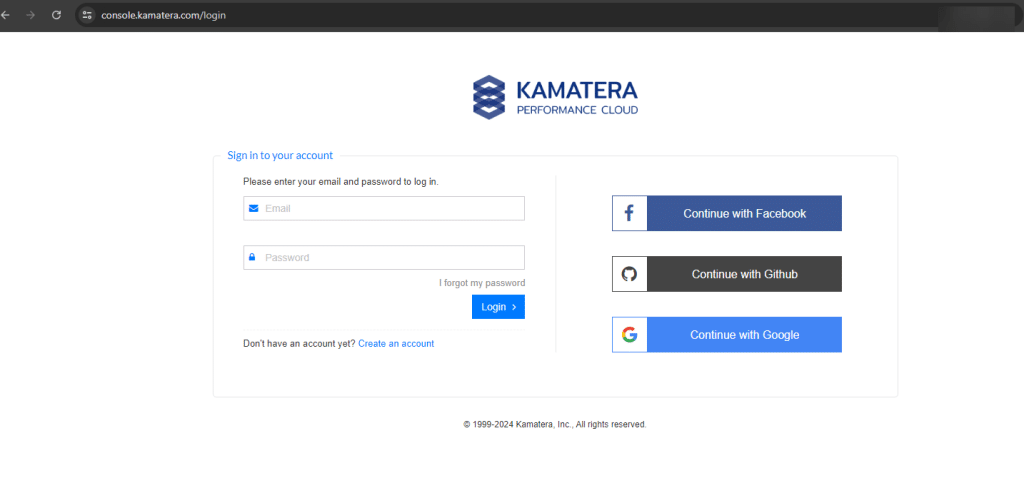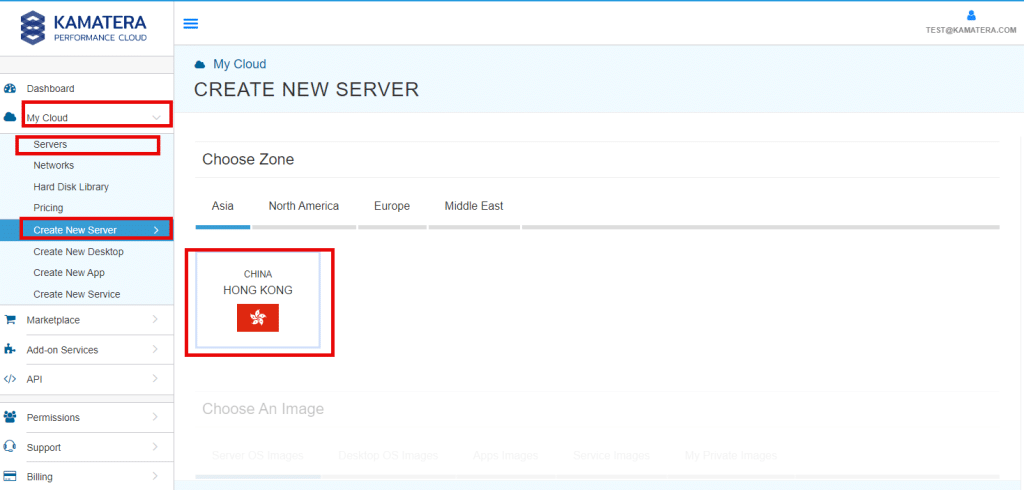CyberPanel is a web hosting control panel that is designed to manage web servers with a user-friendly interface and advanced features. It integrates with LiteSpeed for high performance, including tools for one-click application installation, email management, database handling, and SSL management. It offers robust security features, backup and restore options, DNS management, and supports multi-server environments.
Cyberpanel is ideal for web hosting providers, developers, and small to medium businesses, CyberPanel simplifies server management and enhances hosting capabilities.
CyberPanel is mainly designed to run on Linux-based systems such as Ubuntu or CentOS and does not support Windows. But you can install CyberPanel on Windows by using a Windows Subsystem for Linux (WSL) or Virtual Machine. This guide will walk you through how to install CyberPanel on your Kamatera cloud server.
The first step in the process is to create an account on Kamatera.
Go to console.kamatera.com and sign up for an account by providing the following information:
- Verify Your Email: Click the verification link sent to your email by Kamatera.
- Password: Enter your password.
- Repeat Password: Re-enter your password and click Create Account.
Enter your username and password and click Login to access the Kamatera management console.

- Navigate to My Cloud on left hand side, select Servers and click on Create New Server.
Choose your zone.
- Asia
- North America
- Europe
- Middle East
Note: For this setup, we used the Asia server domain to set up the Windows Server.

- Choose An Image
Kamatera offers a variety of app and server images to help users set up preconfigured resources. Users can explore options such as
- Server OS Images
- Desktop OS Images
- App Images
- Service Images
- My Private Images
In this, select Service Images and select CyberPanel and choose the latest version of CyberPanel.

- Toggle the Detailed view button to enable you to view the detailed description, including the price.

Configure your Kamatera server
Choose server specs:
| Field | Description |
| Type | Type B-General Purpose– Server CPU are assigned to a dedicated physical CPU thread with reserved resources guaranteed.
Type D–Dedicated – –Server CPU are assigned to a dedicated physical CPU Core (2 threads) with reserved resources guaranteed. Type T – Burst – Server CPU are assigned to a dedicated physical CPU thread with reserved resources guaranteed. Exceeding an average usage of 10% will be extra charged for CPUs usage consumption. Type A-Availability- Server CPUs are assigned to a non-dedicated physical CPU thread with no resources guaranteed. Note: More information on CPU types is available on the My Cloud- Pricing page. |
| CPU | Choose the number of vCPUs that will be installed on the server. Type B/T can be configured with upto 104 vCPUs per server. Based on Intel’s latest Xeon Processors, 2.7 GHz+. |
| RAM | Choose the amount of RAM that will be installed on the server. Type B/T/D can be configured with upto 512GB RAM per server. |
| SSD DISK | Choose SSD Storage Size. You can add upto 15 SSD Disk. SSD Storage includes unlimited IOPS and unlimited storage bandwidth, free of charge. |
| Daily Backup | Toggle the switch to enable extended daily backups of your server’s storage to external backup storage. |
| Management Services | Toggle the switch to enable Management Services to the server’s operating system by Kamatera Technical Support Team. |
4.Toggle Daily Backup and Management Services buttons enable or disable according to your requirements.
| Field | Description |
| Daily Backup | Check to add an extended daily backup of your server’s storage to external backup storage. |
| Management services | Check to add management services to the server’s operating system by our Professional Services Support Team |
- Choose Networking
Users can select the network they wish to use, whether it’s a public Internet network or a private local network.

| Field | Description |
| NIC #1 | Select WAN from the options available in the drop-down menu.
Select auto from the options available in the drop-down menu.
Select auto from the options available in the drop-down menu.
|
| WAN Traffic | Select 5000 GB per month/ on 10 Gbit per second port. |
- Advanced Configuration
Hide – If the user wants to hide the advanced configuration.
Show – If you want to see the advanced configuration.

| Field | Description |
| Install Script | Enter the script here to execute once the server is created.
Note: For Windows system use Power Shell. |
| Keep Server On Failure | Do not terminate server if Start up Script or Provisioning Fails |
| Server Notes | Enter any server notes to be noted. |
| Tags | Select the Tags from the drop-down menu and click Add. |
- Finalize Settings
Finalize settings by setting the password, re-validating it, selecting the number of servers, specifying the server name, and enabling the Power On Servers option.

| Field | Description |
| Password | Select password
Password allowed characters: a-z, A-Z,0-9 !@#$^&*()~ and must need the following requirements:
|
| Validate | Re-enter the password to validate. |
| Servers | Select the number of servers the user wants. |
| Name # 1 | Enter the name of the server. |
| Power On Servers | Switch on the toggle button to see the details |
Note: Once the user enters the details in Finalize Settings, they can select either the Monthly Billing Cycle or Hourly Billing, depending on their requirements.
- Billing Cycle and Pricing

The user can choose between the Monthly Billing Cycle and Hourly Billing Cycle.
Note: The Server Summary displays the location, operating system (including server specifications), add-on services, servers, and pricing.
Click Create Server.
- In Tasks Queue, you can see the CyberPanel server is downloading.

- Now, you can see the installation is complete.

Download and run Cyberpanel
11. The CyberPanel server is reflected in the Server Management dashboard. Click on Open, next to the CyberPanel server.

- Click Open beside the CyberPanel server. You can see the overview of server configuration.

- Click CONNECT. Now, click Open Remote Console.

- Login to Ubuntu terminal with username and password.
- Install CyberPanel by running the command below to install required packages.
Command: sudo apt update && sudo apt upgrade
- Download and run the CyberPanel installer
Command:
wget -O installer.sh https://cyberpanel.net/install.sh

- After installation, you can access CyberPanel via your web browser.
- Go to http://your-server-ip:8090 and log in using the admin credentials you set during installation.
- Click Advanced.

- Click Proceed to <ip-address> (unsafe).

18. Now, you can signin using username and password mentioned on ubuntu server. Click Sign in.

- You can use different tabs to navigate through CyberPanel.

Congratulations! You have now successfully installed CyberPanel on your Kamatera cloud server.

















